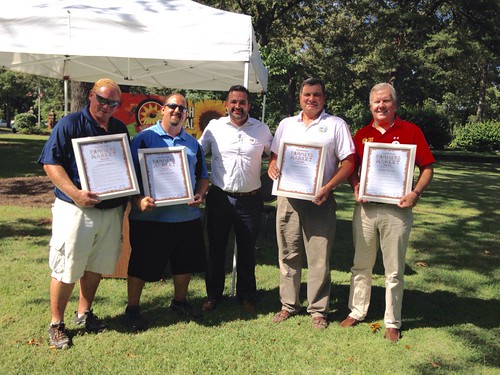
The demand for local food is strong and growing. To meet the growing demand, farmers market managers are becoming creative entrepreneurs who connect rural America to urban and suburban businesses.
Last week, during National Farmers Market Week, I had the pleasure of visiting Crofton Farmers Market in Crofton, Maryland, to recognize state and local efforts to bring fresh foods and economic growth into their community. During my visit, I was given a tour of the market by market managers, Chad Houck and Scott Hariton, who are business partners with a passion for their community.
Throughout my tour, I was amazed by the diversity of products offered, and struck by the evolution of farmers markets over the last few decades. This segment of agriculture is a vibrant growth area that is drawing young people back to rural communities, generating jobs and improving the quality of life in communities. I saw first-hand how farmers markets are bringing people together and providing Americans with fresh products.
With USDA’s continued support, farmers markets and local food systems have seen tremendous growth. In fact, USDA’s National Farmers Market Directory now lists over 8,600 markets, an increase of almost 98 percent between 2006 and 2016.
One of the most appealing aspects of my visit to the Crofton market was when the managers shared their business background as co-owners of a locally grown salsa business, which is also a vendor at the market. To me, this was a perfect display of how farmers markets have become a critical ingredient in local economies providing jobs and opening up direct farm-to-consumer economic transactions. Industry estimates show U.S. local food sales totaled at least $12 billion in 2014, up from $5 billion in 2008, and experts anticipate that value to hit $20 billion by 2019.
Since the 2008 Farm Bill, the Farmers Market Promotion Program (FMPP) has awarded over $58 million through 879 projects to support direct marketing efforts for local food. Recognizing the success of this program, Congress expanded FMPP in the 2014 Farm Bill to include the Local Food Promotion Program (LFPP) to support the aggregation, distribution, storage, and processing of local food. Last year, LFPP funded 191 projects totaling $12.7 million, and the FMPP funded 183 projects totaling $14.4 million. Since 2009, the Specialty Crop Block Grant Program has funded over 250 farmers markets projects totaling $13.5 million to promote fruits and vegetables.
Additionally, many farmers markets vendors provide Supplemental Nutrition Assistance Program (SNAP) and Women, Infants, and Children (WIC) benefits to consumers. In 2015, USDA awarded $8.1 million in grants for projects to enhance the effectiveness of SNAP operations at farmers markets through Farmers Market SNAP Support Grants. All of this has led to SNAP redemptions of $19.4 million at farmers markets in fiscal year 2015. Accepting SNAP benefits at farmers markets is a win-win-win situation. It expands the customer base for farmers and markets, gives SNAP recipients access to healthy foods, and encourages the sale of locally-sourced produce.
The robust business growth at farmers markets also bring community benefits. Sixty-four percent of markets that host community events reported an increase in customer growth. This combination of a diverse vendor base and community-focused activities allows farmers markets to become ideal business models.
With partnerships between farmers, ranchers and agricultural producers continuing to grow, the result it obvious: these opportunities help drive job growth in agriculture, increase entrepreneurship in rural communities, expand food access and choice, and most importantly provide communities with a space to come together and enhance the quality of their lives and their futures.
